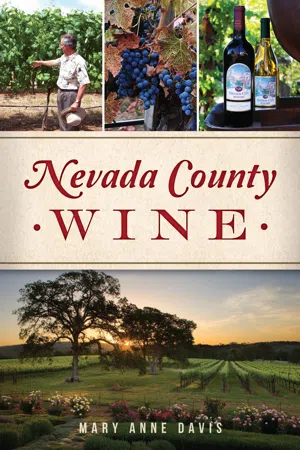
eBook - ePub
Nevada County Wine
Mary Anne Davis
This is a test
- 176 páginas
- English
- ePUB (apto para móviles)
- Disponible en iOS y Android
eBook - ePub
Nevada County Wine
Mary Anne Davis
Detalles del libro
Vista previa del libro
Índice
Citas
Información del libro
Nevada County's tumultuous wine history includes several booms and busts, starting in the 1850s when gold prospectors brought the first grapevines in their saddlebags. Economic downturns, prohibition and war all tried to kill the fledgling wine industry, but it hung on thanks to gentleman farmers and members of the mining industry who supplied a thirsty clientele. Today, although the mines have gone quiet, wineries are thriving in the hills of the Gold Country, and the pioneering spirit lives on in their distinctive vintages and growing techniques. Join author Mary Anne Davis as she explores the family vineyards of the California foothills.
Preguntas frecuentes
¿Cómo cancelo mi suscripción?
¿Cómo descargo los libros?
Por el momento, todos nuestros libros ePub adaptables a dispositivos móviles se pueden descargar a través de la aplicación. La mayor parte de nuestros PDF también se puede descargar y ya estamos trabajando para que el resto también sea descargable. Obtén más información aquí.
¿En qué se diferencian los planes de precios?
Ambos planes te permiten acceder por completo a la biblioteca y a todas las funciones de Perlego. Las únicas diferencias son el precio y el período de suscripción: con el plan anual ahorrarás en torno a un 30 % en comparación con 12 meses de un plan mensual.
¿Qué es Perlego?
Somos un servicio de suscripción de libros de texto en línea que te permite acceder a toda una biblioteca en línea por menos de lo que cuesta un libro al mes. Con más de un millón de libros sobre más de 1000 categorías, ¡tenemos todo lo que necesitas! Obtén más información aquí.
¿Perlego ofrece la función de texto a voz?
Busca el símbolo de lectura en voz alta en tu próximo libro para ver si puedes escucharlo. La herramienta de lectura en voz alta lee el texto en voz alta por ti, resaltando el texto a medida que se lee. Puedes pausarla, acelerarla y ralentizarla. Obtén más información aquí.
¿Es Nevada County Wine un PDF/ePUB en línea?
Sí, puedes acceder a Nevada County Wine de Mary Anne Davis en formato PDF o ePUB, así como a otros libros populares de Histoire y Histoire de l'Amérique du Nord. Tenemos más de un millón de libros disponibles en nuestro catálogo para que explores.
Información
Categoría
HistoireCategoría
Histoire de l'Amérique du Nord1
The Towns of Nevada County
Nevada County is a truly magnificent area in the Sierra Nevada Foothills; its beauty, charm and history are unmatched. From the breathtakingly rugged Sierra Nevada Mountains in eastern Nevada County to the riches in the gold mines and agricultural fields of western Nevada County, the area has an incredibly rich history. Its many museums, state parks, historic buildings and landmarks offer an intriguing glimpse into Northern California’s fascinating past.
Nevada County was created in 1851, when portions from Yuba County, which was quite large at the time, were combined and annexed by the new county. The old county’s boundary lines were changed, and the new county was named after the mining town of Nevada City. The city derived its name from the Sierra Nevada Mountains—Nevada is Spanish for “snowy” or “snow-covered.” Nevada County is one of California’s most scenic and historic regions. Located in the Sierra Nevada Foothills, the county comprises 978 square miles (16 square miles are water), and it is mostly rural, with a population that is just under 100,000. Full of pristine rivers, lakes and lovely forest land, the area was quite awe-inspiring to those who made the journey from the eastern states. When the first wagons crossed the Sierra Nevada Mountains, they cleared the way for the Truckee River route of the California Trail, which came through Nevada County. The site of the ill-fated Donner Party—along with portions of the first transcontinental railroad and the first transcontinental road for automobiles—is also located in Truckee.
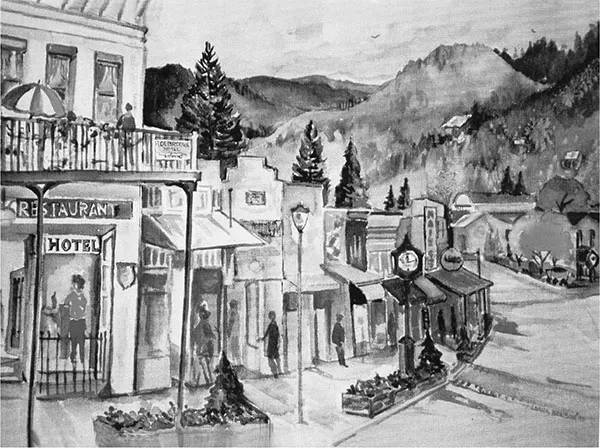
Main Street in Grass Valley. Watercolor painting by Nevada City artist Loana Beason.
There are three incorporated cities in Nevada County: Grass Valley and Nevada City in the western half and Truckee in the eastern half. The county also contains the communities of Penn Valley, Rough and Ready, Washington, Chicago Park, Peardale, North San Juan and French Corral. However, of the almost 100,000 people who live in Nevada County, 65,000 live in the unincorporated areas; only the remaining 30,000 or so residents live within the city limits of Truckee, Nevada City and Grass Valley. There is also quite a steep elevation difference between the eastern and western halves of Nevada County; Penn Valley has an elevation of 1,400 feet, Grass Valley has an elevation of 2,100 feet, Nevada City has an elevation that is closer to 2,500 and Truckee has an elevation that is just over 5,800. To travel from Nevada City to Truckee, one must go over the Donner Summit, which has an elevation of 7,057 feet.
As one would expect, there are significant climate differences between these varied elevations. Like much of Northern California, the western half of Nevada County has a classic Mediterranean climate, with warm summers and rainy winters that can sometimes include snowfall in some of its foothill elevations. These conditions are absolutely ideal when it comes to producing excellent grapes that create wines of distinction. Truckee, on the other hand, is often the coldest town in the nation between June and October; and in the winter, it receives quite a bit of snow, which is not at all conducive to grape growing.
NEVADA CITY
Nevada City is a national landmark town. Dedicated in 1985, Nevada City was recognized in the National Register of Historic Places as “the largest and best preserved historical downtown district in California Gold Country.” The marker dedicated to this recognition is located in Calanan Park, on the corner of Broad and Union Streets in downtown Nevada City.
The plaque reads:
NATIONAL REGISTER OF HISTORIC PLACES
Nevada City, “Queen City of the Northern Mines,” became a town of 10,000 to 16,000 in the early 1850s following the discovery of gold on Deer Creek in 1849. Here is located the largest and best preserved historical downtown district in the California Gold Country. As the county seat of Nevada County, Nevada City has maintained its position as the county’s center of government, professional services and cultural activities since its beginning in 1851.
Entered National Register of Historic Places, September 23, 1985.
Native Sons of the Golden West. Hydraulic Parlor No. 56. Grand Parlor,
Robert Souza, Grand President
Funded by James D. Phelan Trust
In addition to all of the wonderful history in Nevada City, there are three wineries that call the city home: Nevada City Winery, Szabo Vineyards and Double Oak Vineyards and Winery.
GRASS VALLEY
The City of Grass Valley is the largest city in western Nevada County. It was originally known as Boston Ravine and, later, Centerville, but when the post office was established in 1851, the town was renamed Grass Valley. Rumor has it that the town was named by settlers whose cattle had wandered away from their campsite on Greenhorn Creek. They called it “grassy valley,” because it was better grazing for cattle.1
Three of the largest and richest gold mines in California—the Empire Mine, the North Star Mine and the Idaho-Maryland Mine—are located in Grass Valley. At one time, around the 1890s, Grass Valley’s population was about 75 percent Cornish; the tin miners of Cornwall, England, had skills that were needed to mine gold. The town still holds onto its Cornish heritage with Cornish Christmas celebrations and other traditions that are rooted in Cornish history. Downtown Grass Valley is only four miles west of downtown Nevada City, and over the years, the two cities have practically merged as they’ve expanded. It isn’t always easy to tell where one town ends and the other begins.
Four wineries also call Grass Valley home: Sierra Starr Vineyard and Winery, Lucchesi Vineyards and Winery, Avanguardia Winery and Naggiar Vineyards.
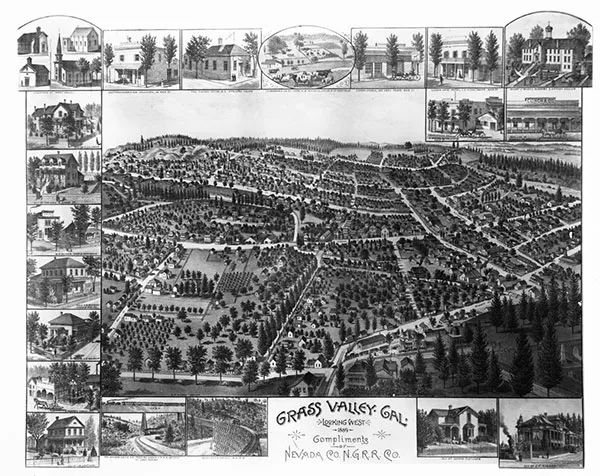
“Grass Valley Gal, Looking West, 1889, Compliments of Nevada Co. N.G.R.R. Co.” Courtesy of Searls Historical Library PIC4-GR-72A.
PENN VALLEY
Located just six miles west of Grass Valley is a town called Penn Valley. In addition to its beautiful scenery, Penn Valley is known for its vineyards, pastures, livestock, Heritage Oaks and the beautiful 88-acre Western Gateway Park. Penn Valley was named after Madame Penn, who, in the early 1800s, homesteaded 320 acres in the area where Squirrel and Grub Creeks intersect. In 1852, James Ennor, a gold miner turned rancher, purchased the property from Madame Penn. He continued to acquire land until the original 320 acres grew to 700 acres, which eventually became a large part of the modern town of Penn Valley.2 This area was also home to the Maidu and Nisenan tribes, and they were followed by gold miners in 1848.
Penn Valley, which is thought to have been one of the first settlements in Nevada County, was also part of a major freight wagon route that served the mining regions in the east and Sacramento in the west. Penn Valley was an important stop along this route because of its livery and blacksmithing services. Penn Valley was also home to a thriving dairy industry, which included a creamery that was reported to be one of the best in California. The Buttermaker’s Cottage in Western Gateway Park was once home to that creamery.
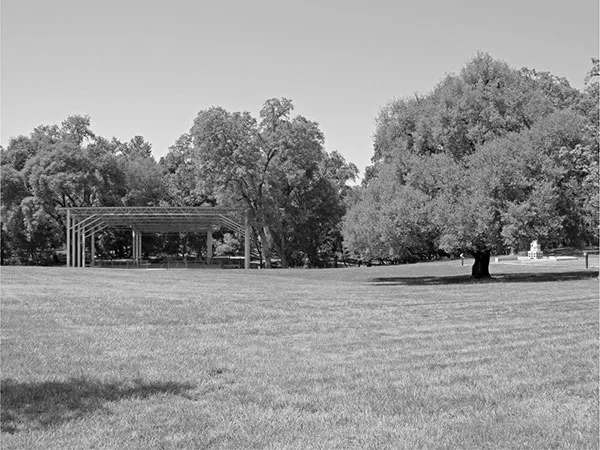
View of the expansive lawn leading down to the amphitheater at Western Gateway Park, Penn Valley. Author photograph.
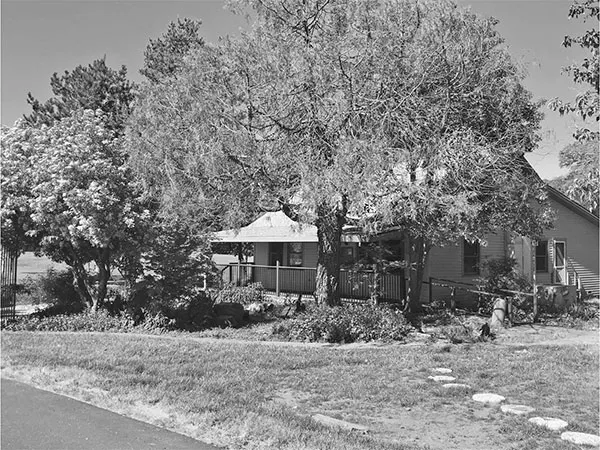
Buttermaker’s Cottage in Western Gateway Park, Penn Valley. Courtesy of Nancy Peirce.
Since the Penn Valley area had rich soil and a warm climate, its leaders attempted to persuade would-be gold miners to be farmers and ranchers. As the gold miners became discouraged, many of them turned to agriculture and farming. This trend led to the area becoming known as the “Pantry of the Northern Mines”; Penn Valley provided fresh fruit, vegetables and meat for freight trains that were heading to mines in states as far away as Nevada.3
Today, Penn Valley is a thriving community that is somewhat split between two town centers: central Penn Valley and a gated residential community called Lake Wildwood. Two wineries are located near Penn Valley: Gray Pine Vineyard and Winery and Pilot Peak Winery.
FRENCH CORRAL
The little town of French Corral has a pretty big claim to fame; in 1877, the Ridge Telephone Company built the world’s first long-distance telephone line in French Corral, which connected it to French Lake (now named Bowman Lake). This line started at the headwaters of the Yuba River and was strung across poles and trees for fifty-eight miles through Nevada County. The line passed through Birchville, Sweetland, North San Juan, Cherokee, North Columbia, Lake City, North Bloomfield, Moore’s Flat, Graniteville and Milton. Thirty “Edison speaking instruments,” or phones, were installed at stations along the route. This was the first use of long-distance telephone wires since the telephone’s invention by Dr. Alexander G. Bell two years earlier. The mine operators in the region immediately saw the benefit of having instant communication; with it, they were able to control the flow of water along the miles of ditches that were used for hydraulic mining.4
This long-distance telephone line was operated by the Milton Mining Company from a building in French Corral that was constructed in 1853. In French Corral, there is a monument called California Historical Landmark 247 that states, “World’s First Long Distance Telephone Line.” It is located three miles east of the Bridgeport Covered Bridge.
ROUGH AND READY
The Great Republic of Rough and Ready, which is located between Grass Valley and Penn Valley, also has its own unique history. Rough and Ready seceded from the United States of America in April 1850, in order to avoid paying taxes on its mining claims.
The town of Rough and Ready elected Colonel E.F. Brundage as their president, and they drafted a constitution with which to govern their new country. This new country lasted until July 4, 1850 (for less than three months), when its citizens realized that they could no longer celebrate the Fourth of July. They quickly convened and, by a popular vote, decided to rejoin the United States of America.
Rough and Ready still celebrates “Secession Days” on the last Sunday in June to remember their short-lived status as the world’s smallest nation.

A replica of an Old West town in Rough and Ready, which belongs to Dr. and Mrs. Jacobitz. The horse’s name is Brady. Author photograph.
NORTH SAN JUAN
Not far from downtown Nevada City (about thirteen miles up California State Route 49) is a town called North San Juan. The town dates back to the California Gold Rush, when it began to prosper from the hydraulic mining that took place in nearby Malakoff Diggins State Historic Park from 1850 to 1884. In 1867, North San Juan was included on the route of the first long-distance telephone line that was stretched between French Corral and French Lake.
The town’s original name, San Juan, was chosen by a Mexican-American War veteran who settled there in 1853 and thought that the land looked like San Juan de Ulua near Veracruz, Mexico. When the town’s post office opened in 1857, the word “North” was added to keep people from confusing it with the town of San Juan in San Benito County.
The modern-day drive to North San Juan is beautiful, although the path through the river canyon can be winding. Today, the community isn’t quite as booming as it was during the gold rush; it consists of a few businesses, organic farms and peaceful homes. While Double Oak Vineyards and Winery is technically in Nevada City, it is much closer to North San Juan.
CHICAGO PARK
Chicago Park (formerly Storms Station) is located about nine miles southeast of downtown Grass Valley on Highway 174. Historically, it was an agricultural and wine-growing community. Prior to the 1840s, this area was populated by the Nisenan, who are sometimes referred to as the Northern Maidu.
Chicago Park got its name from its founding residents, who were developers from Chicago, Illinois. In late 1887, t...
Índice
- Front Cover
- Half Page
- Title Page
- Copyright
- Contents
- Acknowledgements
- Introduction
- 1. The Towns of Nevada County
- 2. History of Wine in California
- 3. Before the Gold Rush: The Nisenan
- 4. Solid Gold
- 5. The Big Three Gold Mines
- 6. There’s So Much More than Gold
- 7. Liquid Gold: The History of Wine in Nevada County
- 8. Agriculture
- 9. Resurgence of the Wine Industry
- 10. Local Wineries and their Histories
- Directory
- Notes
- Bibliography
- About the Author
Estilos de citas para Nevada County Wine
APA 6 Citation
Davis, M. A. (2020). Nevada County Wine ([edition unavailable]). Arcadia Publishing Inc. Retrieved from https://www.perlego.com/book/3023403/nevada-county-wine-pdf (Original work published 2020)
Chicago Citation
Davis, Mary Anne. (2020) 2020. Nevada County Wine. [Edition unavailable]. Arcadia Publishing Inc. https://www.perlego.com/book/3023403/nevada-county-wine-pdf.
Harvard Citation
Davis, M. A. (2020) Nevada County Wine. [edition unavailable]. Arcadia Publishing Inc. Available at: https://www.perlego.com/book/3023403/nevada-county-wine-pdf (Accessed: 15 October 2022).
MLA 7 Citation
Davis, Mary Anne. Nevada County Wine. [edition unavailable]. Arcadia Publishing Inc., 2020. Web. 15 Oct. 2022.